Posted April 12, 2017
By LINGYUE ZHENG
It is usual to have a landmark museum in a city. The Forbidden City in Beijing, the Metropolitan Museum in New Year, Louvre Palace in Paris and Angkor Wat in Siem Reap.
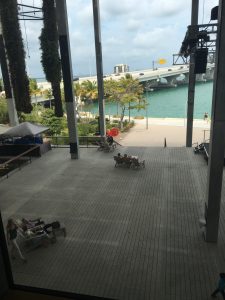
The museum overlooking the beautiful Biscayne Bay (Photos by Lingyue Zheng).
However, Pérez Art Museum Miami (PAMM) is a rare contemporary art museum that not only represents Miami, but itself becomes an artistic masterpiece incorporating its visitors to become part of art.
The Pérez Art Museum Miami (PAMM) is a contemporary art museum that relocated in 2013 to the Museum Park Downtown Miami. Founded in 1984 as the Center for the Fine Arts, it became known as the Miami Art Museum from 1996 until it was renamed in 2013 upon opening.
Its new building, designed by Herzog & de Meuron, is located at 1103 Biscayne Blvd. PAMM, along with the $275 million Patricia Frost Museum of Science and a city park which are being built in the area with completion scheduled for 2015, is part of the 20-acre Museum Park.
The Pérez Art Museum Miami is a three-story building overlooking the Biscayne Bay. As visitors approach the ground-level entrance, they are greeted with astonishing hanging gardens that are suspended from a slatted roof. The gardens are also works of art; vegetation adorns 18-inch-diameter tubes made of fiberglass and felt.
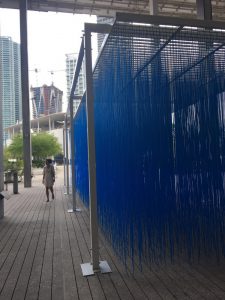
People like walk through the blue tubes and take photos of it.
During exploration in the museum, sometimes one would forget he or she is in a museum. The “out of sight” piece designed by Lawrence Weiner is carved onto the ground and invites you to walk onto it, rows of staircases allures you to have a seat and appreciate the beauty of the architecture, and the vast ocean view slows your pace and makes you linger on the serene nature.
The concept behind the design is to ask visitors to take a minute to contemplate the art, to enjoy the pleasure of relaxation, and invite individuals to be part of a bigger artistic piece— visitors constitute the soul of the Pérez Art Museum.
The museum may never run out of items to display, but it is the visitors who add emotion to the museum and make displayed items become artistic pieces.
A retirement-age couple, hand in hand, relaxes on a bench chair and enjoys the ocean breeze with a Sunday afternoon sunlight. A man sits at a staircase, reading a museum handout. Two young kids dance around the Sculpture Garden in front of the museum. They all add spirit and personality to lifeless items and thus make them art.
The idea of inviting people to be part of art is fully embodied on the second floor, in double-height gallery. A mute film, “It Has a Golden Sun and an Elderly Gray Moon,” by Ulla von Brandenburg, attracts a great many visitors. The film explores tropes that have inspired the artists for more than decades, including architecture, ritual, textiles, dance, and the stage as a mirror of social order.
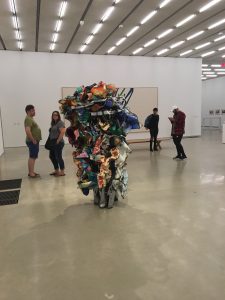
Painted, chromium plated stell. Artist John Chamberlain first began to incorporate scrap metal from used cats into his work.
Alluding to the ingenuity of theater, Von Brandenburg creates immersive installation that reconsiders collective experiences and questions the role of the individual in social hierarchies.
In both walking through the gallery and watching the video, visitors can observe ritualistic motifs at work in this piece.
The performers seem to be under a type of trance, in repetitive clapping, stooping and dancing, as they confront the staircase with their colored fabrics.
Believing in that different colors would evoke different emotional response, von Brandenburg changes the colored textiles featured in the dancers’ movements in the video to illustrate the personal struggles with the collective.
At the end of the scene, the camera turns away from performers, revealing that they are performing in an empty theater. When museum visitors sit on the first step of the gallery staircase to view the video, they too become, in the end, performers interacting with the unique structure.
Von Brandenburg’s gallery skillfully incorporates visitors to his art project and successfully immerses viewers in a flow of artistic presentation. This concept resonates with the presentation form of theater, “Sleep No More.”
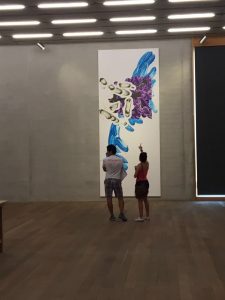
David Reed used different shades of color to convey different emotion.
“Sleep No More” is an innovative play based on Shakespeare’s “Macbeth”. It is considered promenade theater in which the audience walks at their own pace through a variety of theatrically designed rooms, as well as environmental theater, in which the physical location, rather than being a traditional playhouse, is an imitation of the actual setting.
“Sleep No More” is best described as immersive theater rather than interactive theater, because although the audience may move through the settings, interact with the props, or observe the actors at their own pace, their interference has no bearing on the story or the performers except in rare instances.
During a visitor’s exploration, he or she may wander through any of the five visible levels of settings and interact with different props.
Sometimes, they are even allowed to interact independently with one or two actors or actresses. In this way, audiences have more personal experience with art and have a better understanding of participation in art.
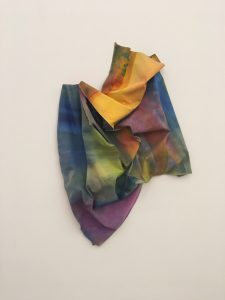
The artist Sam Gilliam was inspired by the laundry hanging of his studio to create this Blue and Flame.
The idea behind the theater “Sleep No More” is similar to the concept of the Pérez Art Museum, in which designers think art is not exclusive to certain individuals, nor intangible or abstract objects, they are emotional, personal and right next to you.
Pérez Art Museum is not the type of museum with a sea of artistic pieces that would devour your artistic senses, rather, it is tranquil and empty place that sometimes evokes your imagination and deep thoughts.
Combined with its breathtaking sea view, exquisite arrangement and calm vibe, the museum invite visitors to discover and explore art, create art and be part of the art itself.
- Pérez Art Museum Miami www.pamm.org
- 1103 Biscayne Blvd., Miami
- Contact: 305-375-3000
- Operation Hours: open 10 a.m. to 6 p.m. Tuesdays and Wednesdays, Fridays-Sundays; 10 a.m. to 9 p.m. Thursdays.
- Admission: adults, $16; seniors, students and youth ages 7-18, $12.
